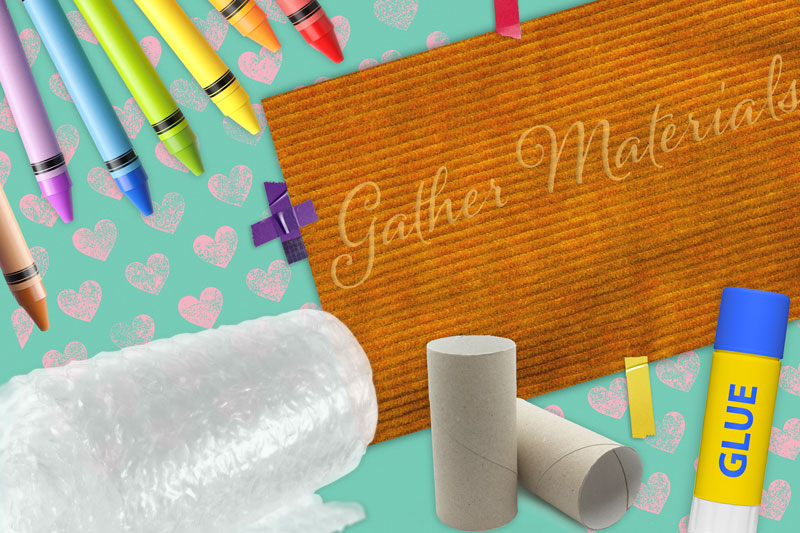Take-Home Activity Kits for Little Library Visitors | First Steps
Libraries are providing rich, creative sensory experiences to the young children who need it most. Here are ideas for stimulating, hands-on activities.

Since the pandemic started, Brooklyn Public Library (BPL) has created free “Grab and Go” activity kits, which are colorfully nestled by the checkout machines at the Flatbush Library branch. Four-year-old Twyla and her mom, Melanie, are fans. “They give out arts and crafts!” Twyla says. “We pick up Ziploc bags of craft supplies almost each time we visit,” Melanie adds. “It [feels] like a treat.”
Virtual programming has been a vital way to keep us connected while in-person programming is suspended due to COVID-19. Many libraries are providing rich, creative sensory experiences to the young children who need it most. Here are ideas for hands-on, take-home activities from librarian colleagues across the country.
Open-ended explorations: Tom Burnett, director of early childhood at the Children’s Museum of the Arts in Manhattan, recommends that librarians and educators provide open-eneded materials to encourage artistic exploration. “Let go of your expectations of how an art project should be completed. Let the child decide how the art materials will be used,” he says. “Instructions at an early age can be overwhelming and prevent exploration—the essence of creative thinking.” Gather materials with various textures (bubble wrap, corduroy, foil, etc.) and put them in a zip closure bag with a piece of self-adhesive paper to encourage little ones to create a tactile collage at home.
Story time materials: While we may encourage families to use a dish towel as a story time scarf or a box of dry pasta as a shaker during virtual story time, why not create “Follow-Along” kits like Kate Grafelman, children’s programming librarian at the Bartholomew County (IN) Public Library, does? The circulating kits include scarves, shakers, rubber stamps, song and rhyme activities that use these props, and supplies to make a shaker to keep. Families can use the kit to “follow along” with BCPL’s YouTube playlist of story time videos.

Sensory fun: For preschoolers doing much of their formal learning via screen, sensory play is increasingly vital. Ann Santori, early literacy specialist librarian of the Lincolnwood (IL) Public Library District, sends home sensory kits with water beads or dyed rice in a sealed plastic bag with some animal figures for toddlers to seek and find.
STEM! Take a tip from Suzanne Brizzi, senior library assistant for the Cobb County (GA) Public Library System, who uses everyday materials in STEM take-and-make kits. Brizzi sends home items to build and engineer with such as old CDs, bottle caps, paper cups, and tubes from receipt printers, encouraging parents and kids to think green and proving that STEM is everywhere.
Practical tips
• Offer families “starter kits” with basics like child-safe scissors, glue sticks, crayons, and paper.
• Don’t make using the materials contingent on viewing a virtual program. Families may not have computer access or schedules that align with programming.
• Promote pickup times and locations in your events calendar or via social media listing what each kits includes and the intended age.
• Have fun with branding! Use stickers with your library logo and color code by age group. Some librarians have gotten creative using free templates in Canva.
Activity kits encourage hands-on learning in a screen-heavy moment, and distributing them also reignites in-person connections. BPL may continue with kits post-pandemic to serve families who don’t have access to these materials or who can’t come to in-person programs due to disability, scheduling, or other barriers. As one parent said last year: “When you don’t have a lot to give right now, this was like an early Christmas present.’”
 Rachel G. Payne is coordinator of early childhood services at Brooklyn Public Library. Jessica Ralli is coordinator of early literacy programs at BPL.
Rachel G. Payne is coordinator of early childhood services at Brooklyn Public Library. Jessica Ralli is coordinator of early literacy programs at BPL.
RELATED
The job outlook in 2030: Librarians will be in demand
The job outlook in 2030: Librarians will be in demand
ALREADY A SUBSCRIBER? LOG IN
We are currently offering this content for free. Sign up now to activate your personal profile, where you can save articles for future viewing






Add Comment :-
Be the first reader to comment.
Comment Policy:
Comment should not be empty !!!